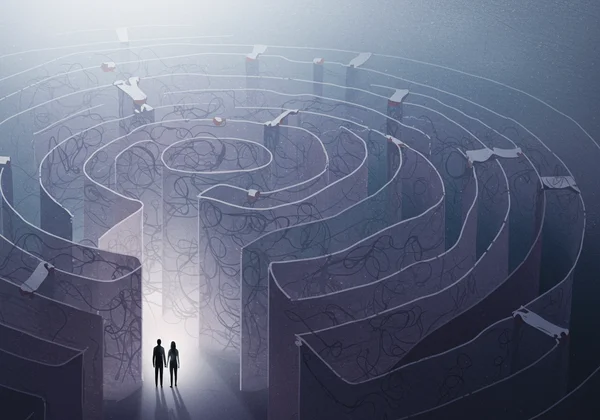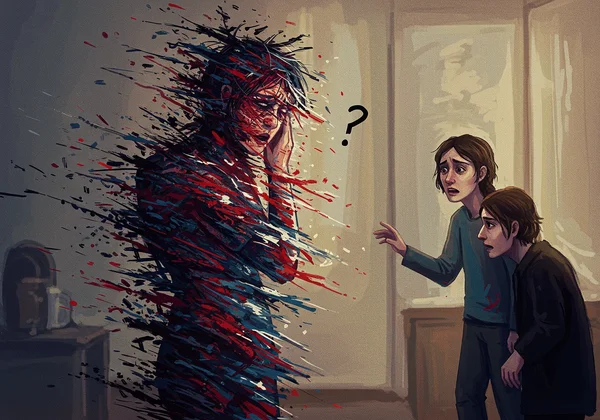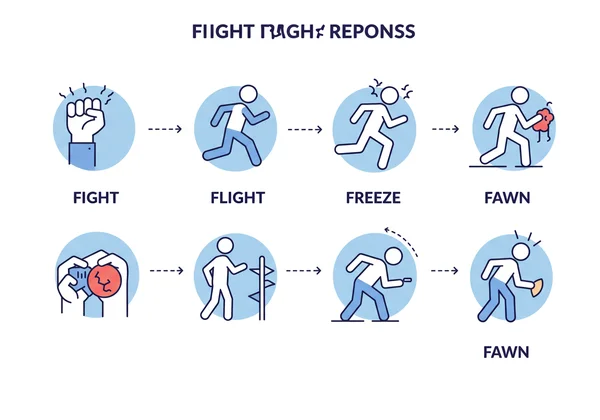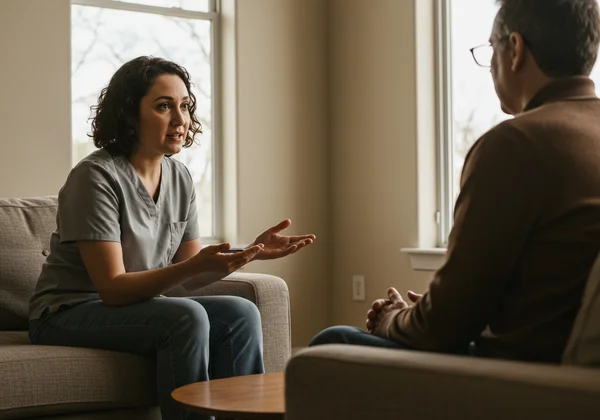Navigating CPTSD in Relationships: Take a CPTSD Test & Start Healing
For many, the desire for deep, meaningful connection is a fundamental part of being human. Yet, when you're living with the echoes of long-term trauma, that desire often clashes with a painful reality. The world of CPTSD in relationships can feel like a labyrinth of confusion, fear, and heartbreak. You might crave intimacy while simultaneously pushing it away, leaving both you and your loved ones feeling lost. How can I tell if I have CPTSD and if it's the root of these relational struggles?
This guide is here to offer validation, clarity, and compassionate guidance. We will explore how Complex PTSD impacts your connections and provide actionable steps toward building the healthier, safer bonds you deserve. Understanding the "why" behind your challenges is the first step toward healing, and a great place to start is with a confidential and insightful CPTSD self-assessment.

The Impact of CPTSD in Relationships: Understanding the Dynamics
Complex PTSD doesn't just live in the past; it actively shapes your present, especially in how you relate to others. It’s not a personal failing or a character flaw. It's a set of survival adaptations that, while once necessary, now create significant barriers to intimacy and trust. Recognizing these patterns is crucial for breaking free from them.
How Distrust & Fear Affect Connection with CPTSD
For survivors of prolonged trauma, the world often felt unsafe, and people were unpredictable. This learned experience creates a deep-seated distrust that is difficult to shake. You may find yourself constantly scanning for signs of betrayal, criticism, or abandonment, even with a partner who has proven to be trustworthy. This hypervigilance is exhausting and can make true vulnerability feel impossible.
This fear isn't just about being hurt again; it's a profound fear of annihilation or losing yourself in the connection. This can manifest as needing constant reassurance or, conversely, creating emotional distance to protect yourself. If you're wondering if these patterns resonate with you, a free CPTSD test can provide initial clarity.
Emotional Dysregulation: Navigating Intense Feelings with Loved Ones
One of the hallmark symptoms of CPTSD is difficulty managing emotions. In a relationship, this emotional dysregulation can be incredibly disruptive. A minor disagreement might trigger an overwhelming wave of anger, shame, or terror that feels disproportionate to the situation. These are often emotional flashbacks, where feelings from past trauma bleed into the present moment.
Your partner may be confused by these sudden shifts, interpreting them as attacks or instability. For you, it can feel like your emotions are hijacking you, leading to cycles of conflict, guilt, and withdrawal. Learning to identify your triggers is a key part of managing these intense feelings and fostering a more stable connection.

The Inner Critic & Negative Self-View in Relational Dynamics
Chronic trauma teaches you damaging lessons about your self-worth. It often fosters a harsh inner critic that relentlessly tells you that you are flawed, unlovable, or fundamentally broken. This negative self-perception becomes a lens through which you view your relationships.
You might struggle to accept love and compliments, believing you don't deserve them. You may unconsciously self-sabotage the relationship to prove your inner critic right or tolerate unhealthy behavior because you believe it's all you're worthy of. Quieting this internal voice is a vital part of healing your ability to give and receive love freely.
Exploring CPTSD Attachment Issues: Patterns & Pathways
Our earliest relationships form a blueprint for how we connect with others throughout life. When those foundational bonds are shaped by trauma, it can lead to insecure cptsd attachment issues. Understanding your attachment style isn't about placing blame; it's about recognizing ingrained patterns so you can consciously choose new, healthier ones.
Recognizing Common Attachment Styles Shaped by Complex Trauma
While every individual is unique, complex trauma often contributes to specific insecure attachment styles. Many survivors exhibit a fearful-avoidant (or disorganized) attachment, where they simultaneously crave closeness and are terrified of it. This creates a push-pull dynamic that is deeply confusing for both partners.
Others may develop an anxious-preoccupied style, marked by a fear of abandonment and a constant need for validation. Conversely, a dismissive-avoidant style might emerge, where emotional intimacy is suppressed in favor of staunch independence. Identifying your tendencies is a powerful step, and a comprehensive CPTSD quiz can offer insights into how these patterns show up for you.
The "Fight, Flight, Freeze, Fawn" Responses in Intimate Bonds
The "4 Fs" are automatic survival responses hardwired into our nervous systems. In the context of CPTSD, these trauma responses can be chronically activated within relationships, even when there's no real danger.
- Fight: Manifests as defensiveness, criticism, or controlling behavior during conflict.
- Flight: Leads to emotional or physical withdrawal, avoiding difficult conversations, or ending relationships abruptly.
- Freeze: Appears as feeling numb, disconnected, or "spacing out" during moments of intimacy or stress.
- Fawn: Involves people-pleasing, abandoning your own needs to keep your partner happy, and struggling to set boundaries.
Recognizing which of these responses you default to can help you interrupt the cycle and respond more intentionally.

Healing Relational Trauma: Actionable Steps for Healthier Bonds
While the challenges are real, so is the capacity for healing and growth. Finding cptsd and love that is healthy and fulfilling is entirely possible. The journey of healing relational trauma involves building safety within yourself first, and then extending that safety into your connections with others.
Building Internal & External Safety for CPTSD & Love
Safety is the foundation of all healing. Building safety starts from within. This involves learning grounding techniques to manage emotional flashbacks, practicing self-compassion to soothe the inner critic, and creating a life that feels stable and predictable. When you feel safer in your own skin, you become less reactive in your relationships.
External safety involves choosing partners who are respectful and emotionally available. It also means establishing clear boundaries that protect your well-being. This creates a secure base from which you and your partner can navigate challenges together. If you're ready to understand your symptoms better, our assessment can be a safe starting point.
Effective Communication Strategies for CPTSD in Relationships
Many relational conflicts stem from miscommunication fueled by trauma triggers. Adopting effective communication habits can transform your interactions. This includes using "I" statements to express your feelings without blame (e.g., "I feel scared when..." instead of "You make me feel...").
Learning to listen actively and validate your partner's perspective, even if you disagree, builds immense trust. It’s also crucial to learn how to ask for a "timeout" during a conflict when you feel overwhelmed, allowing you to regulate your nervous system before re-engaging.
When to Seek Professional Support for Relationship Challenges
Healing from complex trauma is not a journey you have to take alone. Seeking professional support from a trauma-informed therapist can be life-changing. A therapist can provide you with tools to regulate your emotions, process past trauma, and develop secure attachment patterns using evidence-based approaches like Eye Movement Desensitization and Reprocessing (EMDR).
Couples therapy can also be invaluable, creating a safe space for you and your partner to understand each other's triggers and develop healthier ways of relating. Taking a preliminary cptsd test online can be a helpful first step to gather your thoughts before speaking with a professional.

Take the Next Step: Healing & Connection with CPTSD
Navigating relationships with CPTSD is undeniably challenging, but it is not a life sentence of loneliness or conflict. By understanding how trauma impacts your connections, recognizing your patterns, and taking intentional steps toward healing, you can build the secure, loving relationships you long for. Remember to be patient and compassionate with yourself throughout this process.
Your journey to understanding begins with a single step. If you recognize yourself in these pages, we invite you to take our free, confidential, and science-based CPTSD test. It can provide you with personalized insights that validate your experience and illuminate the path toward healing and connection. Start your journey today.
Frequently Asked Questions About CPTSD & Relationships
Can people with CPTSD have healthy relationships and find love? Absolutely. While CPTSD presents unique challenges, healing is possible. Through self-awareness, developing coping skills, effective communication, and often with professional support, individuals with CPTSD can build secure, lasting, and deeply loving partnerships. The key is committing to the healing journey.
How does CPTSD affect everyday struggles in a relationship? CPTSD can magnify everyday struggles. A simple disagreement can feel like a major threat, triggering a trauma response. It can also create difficulties with decision-making, sharing household responsibilities (due to executive dysfunction), and maintaining emotional and physical intimacy, turning minor issues into significant conflicts.
What does a CPTSD trigger look like in romantic partnerships? A trigger can be subtle or overt. It could be a specific tone of voice, a perceived criticism, feeling ignored, or even a moment of intense happiness that feels unsafe. The reaction might be a sudden mood swing, withdrawing and becoming non-communicative (freeze), lashing out in anger (fight), or an overwhelming need to please your partner (fawn). Understanding your personal triggers is a crucial step you can begin to explore with our free online test.
Is CPTSD mistaken for other issues in relationships, like BPD? Yes, frequently. There is an overlap in symptoms like emotional dysregulation and fear of abandonment between CPTSD and Borderline Personality Disorder (BPD). However, the core of CPTSD, as defined by sources like the World Health Organization's ICD-11, is rooted in trauma and often involves negative self-concept and persistent shame, whereas BPD is centered more on a frantic fear of abandonment and an unstable sense of self. A proper screening and professional consultation are key to differentiation.
Disclaimer: This article is for informational purposes only and does not constitute medical advice. The CPTSD screening test provided here is a screening tool, not a diagnostic instrument. Please consult with a qualified mental health professional for a formal diagnosis and treatment plan.